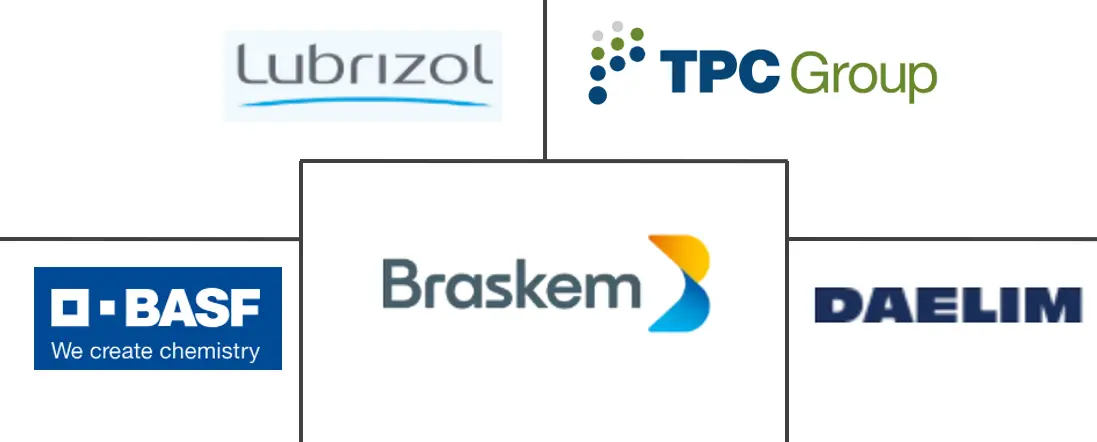Polyisobutylene (PIB) Market Size and Share
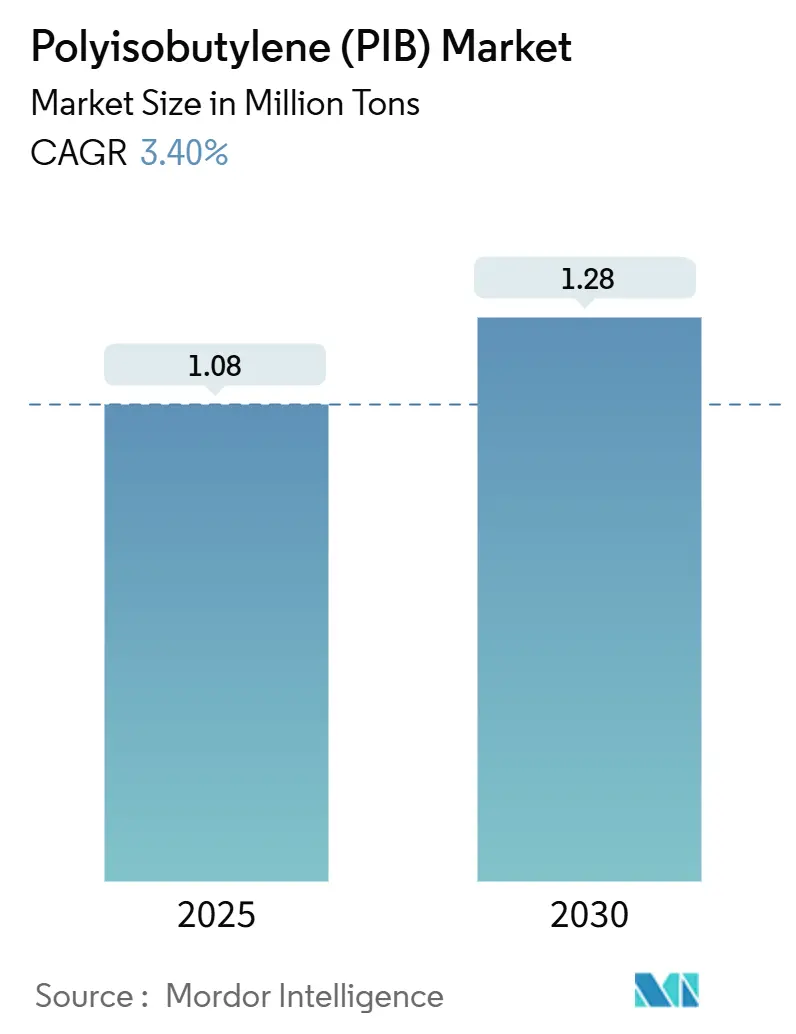
Polyisobutylene (PIB) Market Analysis by Mordor Intelligence
The Polyisobutylene Market size is estimated at 1.08 million tons in 2025, and is expected to reach 1.28 million tons by 2030, at a CAGR of 3.40% during the forecast period (2025-2030). Demand continues to coalesce around high-performance lubricant additives, adhesive systems, and tubeless tire compounds, all of which rely on the polymer’s inherent gas impermeability, thermal stability, and chemical inertness. Intensifying electrification of vehicles is widening the performance envelope for engine oils, driveline fluids, and battery-coolant formulations, deepening the need for viscosity-modifying grades of polyisobutylene. At the same time, regulatory pressure on volatile organic compound emissions in construction materials is steering sealant producers toward PIB-based solutions that offer compliance without reformulation trade-offs. Capacity expansions in Asia-Pacific, especially integrated projects in China and India, are expected to relieve localized supply tightness while reinforcing the region’s cost advantage in the global polyisobutylene market.
Key Report Takeaways
- By application, lubricants captured 44.14% of polyisobutylene market share in 2024 and also delivered the fastest 3.72% CAGR through 2030.
- By end-use industry, automotive and transportation commanded 46.64% share of the polyisobutylene market size in 2024 while advancing at a 3.84% CAGR to 2030.
- By geography, Asia-Pacific accounted for 39.39% of polyisobutylene market share in 2024 and is expanding at the highest 4.06% CAGR through 2030.
Global Polyisobutylene (PIB) Market Trends and Insights
Driver Impact Analysis
| Drivers | (~) % Impact on CAGR Forecast | Geographic Relevance | Impact Timeline |
|---|---|---|---|
| Growing demand from adhesives and sealants | +0.8% | North America, Europe | Medium term (2-4 years) |
| Rising demand for inner-liner and tubeless tires | +0.9% | Asia-Pacific, spill-over North America | Short term (≤ 2 years) |
| Expanding use as viscosity modifier in lubricants | +1.1% | Asia-Pacific, North America | Long term (≥ 4 years) |
| Shift toward highly-reactive PIB additives | +0.7% | North America, Europe, Asia-Pacific | Medium term (2-4 years) |
| PIB binders for Si-rich Li-ion battery anodes | +0.5% | Asia-Pacific (China) | Long term (≥ 4 years) |
| Source: Mordor Intelligence | |||
Growing Demand from Adhesives and Sealants
Robust construction activity and vehicle-lightweighting programs continue to push formulators toward PIB-based bonding systems that eliminate isocyanates and other volatile components. New European Union restrictions on diisocyanate content above 0.1% have accelerated the move to non-PU structural adhesives, with PIB chemistries now favored for their low toxicity profile and excellent wet-out on diverse substrates. PIB sealants also provide lasting weather resistance, making them attractive for curtain-wall glazing, rooftop membranes and photovoltaic mounting systems. Growth prospects are underpinned by sustainability targets that penalize solvent-borne alternatives, reinforcing the trajectory of the polyisobutylene market toward eco-compliant materials.
Rising Demand for Inner-Liner and Tubeless Tire Compounds
Tubeless passenger-car and commercial-vehicle tires rely on isobutylene-isoprene rubber derived from PIB to maintain inflation pressure over the service life of the tire. Electric-vehicle platforms intensify this requirement by targeting lower rolling resistance and augmented safety, which in turn lifts polymer grade demand in Asia-Pacific’s tire manufacturing clusters. Chemically modified PIBs such as chlorobutyl and bromobutyl extend co-vulcanization capability while preserving low gas permeability, sustaining a strong pull for premium, performance-oriented grades in the polyisobutylene market.
Expanding Use as Viscosity Modifier in Next-Gen Lubricants
Polyisobutylene continues to serve as the workhorse viscosity-index improver in multi-grade engine oils, driveline fluids, and industrial hydraulic lubricants. Lubrizol’s PV1710 additive family, released to meet the forthcoming GF-7 standard, exemplifies how advanced PIB architectures allow base-oil blenders to meet simultaneously tougher fuel-economy and emissions thresholds[1]Lubrizol, “Get Ready for GF-7 With Additive Solutions from Lubrizol,” lubrizol.com. As mobility transitions to electrified and hybrid powertrains, drive-axle and thermal-management fluids maintain high viscosity demands, thereby reinforcing the growth outlook for the polyisobutylene market.
Shift Toward Highly-Reactive PIB for Fuel and Lube Additives
High-reactive PIB (HR-PIB) delivers a greater fraction of reactive double bonds at the terminus of the polymer chain, facilitating more efficient synthesis of detergents, dispersants and pour-point depressants. Fuel-economy and emissions regulations are pushing formulators to adopt HR-PIB because it enables lower treat rates without sacrificing engine cleanliness. Established producers are converting legacy assets or debottlenecking lines to raise HR-PIB output, indicating that the sales mix within the polyisobutylene market will continue tilting toward higher-value, functionally optimized grades over the forecast horizon.
Restraint Impact Analysis
| Restraints | (~) % Impact on CAGR Forecast | Geographic Relevance | Impact Timeline |
|---|---|---|---|
| Feedstock isobutylene price volatility | -0.6% | North America, Global | Short term (≤ 2 years) |
| Intrinsic UV instability of PIB | -0.4% | Global (higher in high-UV zones) | Medium term (2-4 years) |
| Tightening VOC/REACH rules on solvent products | -0.5% | Europe, rolling global | Long term (≥ 4 years) |
| Source: Mordor Intelligence | |||
Intrinsic UV Instability Requiring Costly Stabilizers
Without antioxidants and UV absorbers, PIB undergoes surface cracking and discoloration when exposed to sunlight. Outdoor applications therefore impose additional additive packages, raising formulation costs relative to inherently UV-stable alternatives. Advances in hindered-amine light stabilizers have trimmed treat-rates, but cost sensitivity in roofing membranes and exterior sealants still limits adoption in certain price-constrained regions.
Tightening VOC/REACH Rules on Solvent-Borne PIB Products
European regulations now restrict high-solids solvent systems, accelerating a shift to water-borne and hot-melt formulations. PIB solutions used in contact cements and metal-protection fluids are under scrutiny, requiring producers to re-engineer products or secure exemptions. Compliance investment diverts capital from capacity debottlenecking, modestly tempering the long-range growth trajectory of the polyisobutylene market.
Segment Analysis
By Application: Lubricants Drive Performance-Oriented Demand
Lubricants represented 44.14% of the polyisobutylene market size in 2024 while advancing at 3.72% CAGR through 2030 as multi-grade engine oils, driveline fluids and hydraulic oils intensify reliance on viscosity-index improvers. PIB’s thickening efficiency, low-temperature solvency, and shear-stability underpin its continued dominance despite competing olefin copolymers. Fuel additives form a smaller yet strategic niche where PIB succinimides act as detergents, safeguarding high-pressure fuel-injector cleanliness in both spark-ignition and compression-ignition engines.
The broader application slate keeps the polyisobutylene market insulated from single-sector cyclicality. Adhesives and sealants gain momentum from green-building codes favoring low-VOC materials, with PIB sealants displaying negligible moisture migration that extends the service life of insulating-glass units. Inner-liner compounds for tubeless and run-flat tires remain robust thanks to safety regulations and growing electric-vehicle (EV) volumes. Plasticizer, electrical-insulation, and specialty-chemical outlets provide incremental tonnage that rounds out demand, making lubricants the lodestar while diversifying risk exposure for global suppliers.
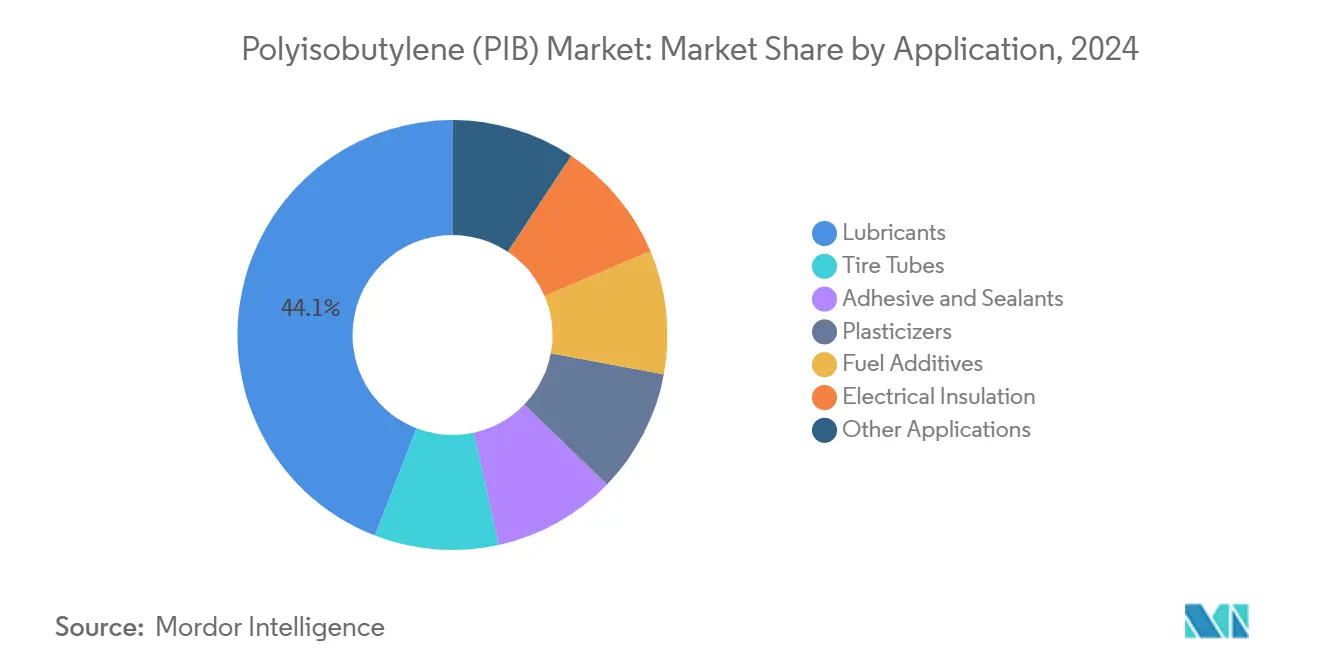
Note: Segment shares of all individual segments available upon report purchase
By End-Use Industry: Automotive Transformation Sets the Pace
Automotive and transportation consumed 46.64% of polyisobutylene market share in 2024 and posted a 3.84% CAGR through 2030, reflecting broadening utilization in engine oils, e-drive lubricants, tire compounds, and battery enclosures[2]BASF, “OPPANOL® PIB,” basf.com . Tight CO₂ targets drive OEMs to adopt low-viscosity lubes fortified with PIB VI improvers that cut parasitic losses while protecting hardware under turbocharged, high-BMEP conditions. EV uptake does not lessen the polymer’s relevance; rather, it redirects consumption toward thermal-management fluids and functional adhesives in lightweight body-in-white structures.
Industrial machinery follows as the second-largest consumer owing to escalating automation and higher operating pressures in hydraulics. Construction materials profit from PIB’s resistance to alkalis, acids, and weathering, qualities prized in civil-engineering sealants, waterproofing membranes, and expansion joints. Food, pharmaceutical, and personal-care applications employ low-molecular-weight PIB grades as moisture-barrier films and cosmetic emollients, exploiting the polymer’s inertness and FDA compliance. Electrical and electronics end-uses, including cable-joint compounds and transformer-oil sealants, round out demand diversity, reinforcing the structural resilience of the polyisobutylene market.
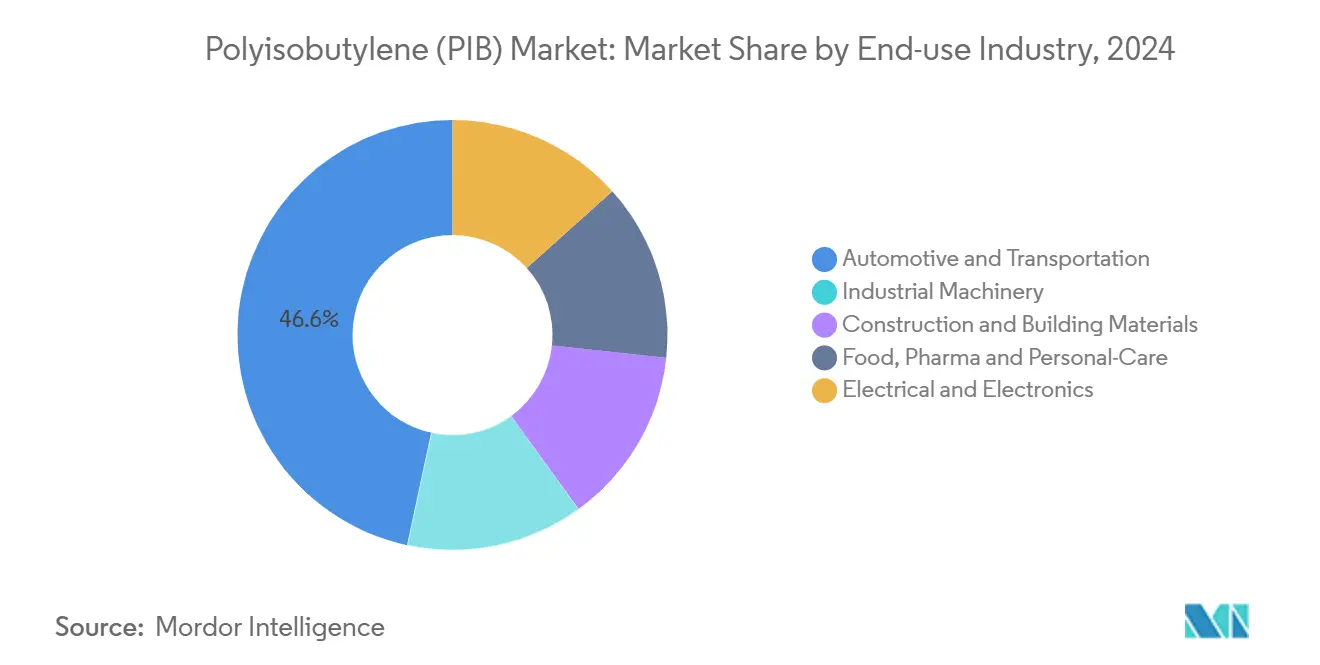
Note: Segment shares of all individual segments available upon report purchase
Geography Analysis
Asia-Pacific accounted for 39.39% of polyisobutylene market share in 2024 and is expanding at a 4.06% CAGR to 2030 on the back of capacity additions and relentless growth in downstream tire, lubricant and adhesive industries. China anchors regional demand through its status as the world’s largest vehicle producer and a front-runner in battery manufacturing. India is quickly narrowing the gap; Lubrizol’s USD 200 million Aurangabad plant will deliver medical-grade and performance-chemical PIB variants once completed, demonstrating the draw of local market growth as well as export potential into the Middle East and Africa.
North America houses integrated C4 complex operators and benefits from shale-derived feedstock economics. PIB produced in the U.S. Gulf Coast supplies automotive hubs in the Midwest and Mexico, while specialty grades serve lubricant blenders on both coasts. Europe remains technology-focused, channeling PIB into high-value adhesives, dispersants, and HR-PIB derivatives that comply with REACH. Legislative mandates for lower VOC and carbon footprints are nudging formulators toward highly functional PIB chemistries that can reduce overall additive treat rates.
South America, the Middle East and Africa collectively absorb a modest yet rising share of polyisobutylene market volume. Latin American tire producers and construction sectors stimulate regional pull, whereas the Gulf Cooperation Council pursues PIB projects aimed at integrating refinery streams with specialty-chemical value addition. Africa’s nascent industrialization and automotive assembly investments are expected to open new PIB sales corridors as infrastructure modernization accelerates through 2030.
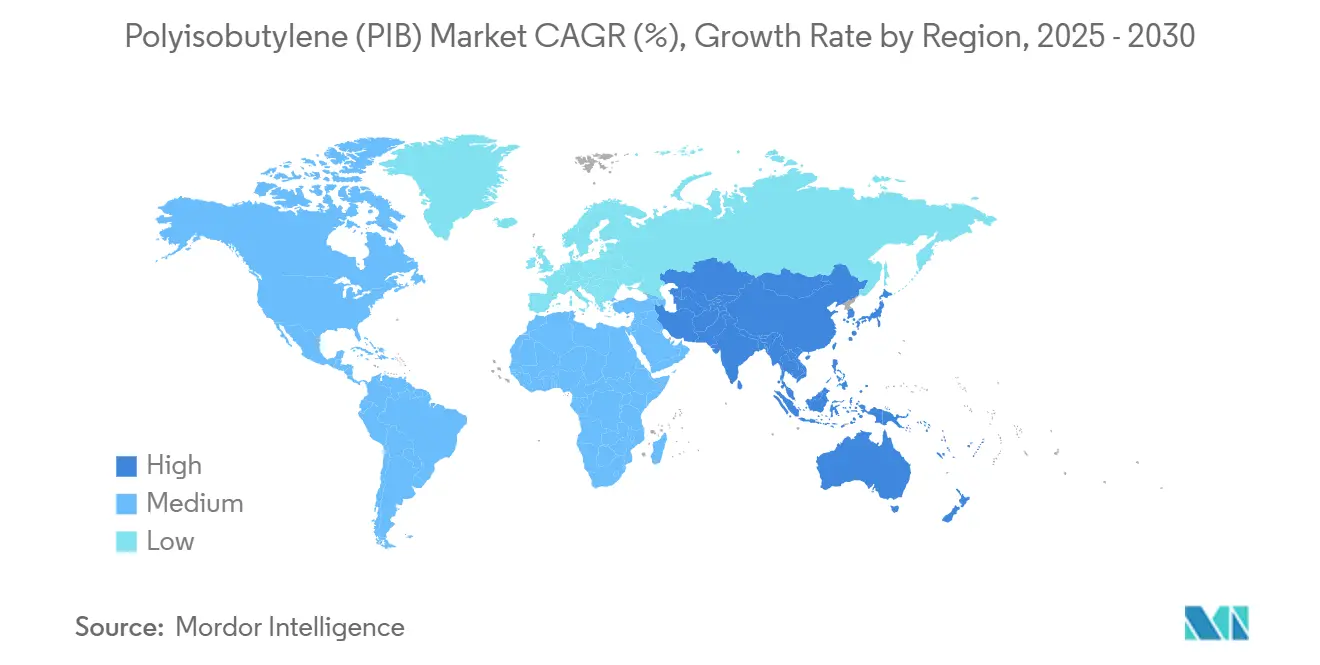
Competitive Landscape
The polyisobutylene market is moderately fragmented. BASF builds on more than eight decades of PIB manufacturing know-how and markets the OPPANOL and GLISSOPAL families that span a broad molecular-weight spectrum. Strategic initiatives increasingly revolve around HR-PIB debottlenecking, circular-economy pilot lines, and alliances with lubricant additive formulating arms. Titan broke ground on a facility to double its low-molecular-weight PIB output, targeting import substitution and export markets once geopolitical constraints ease. Technology licensing by equipment suppliers is fostering a broader manufacturing landscape, though new entrants face high capital intensity and stringent product-quality benchmarks, reinforcing the competitive moats of incumbents across the polyisobutylene market.
Polyisobutylene (PIB) Industry Leaders
-
Braskem
-
The Lubrizol Corporation
-
BASF
-
Daelim Co., Ltd
-
TPC Group
- *Disclaimer: Major Players sorted in no particular order
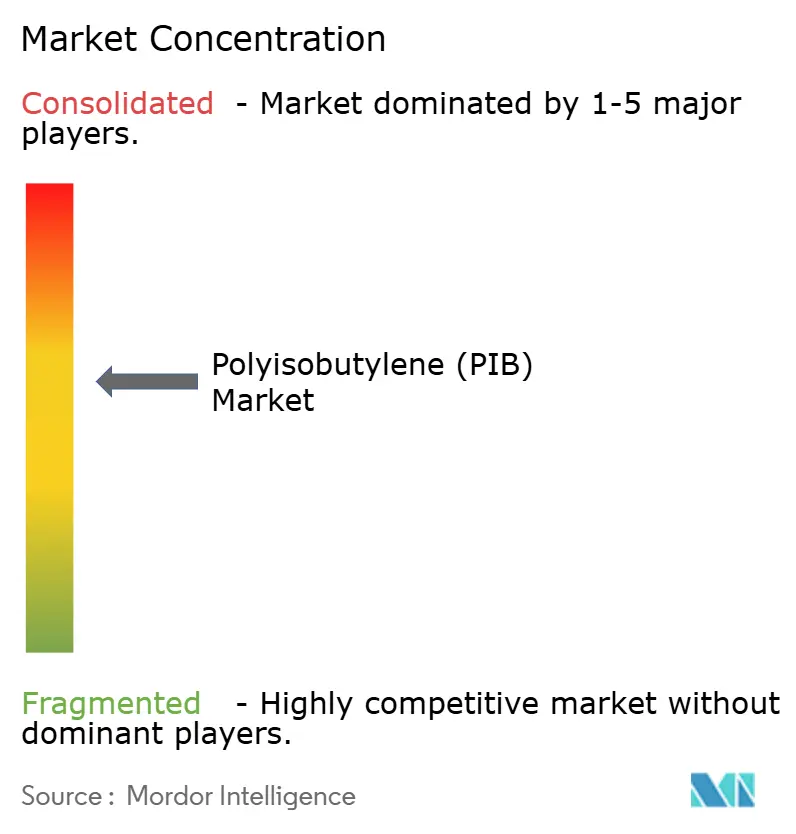


Recent Industry Developments
- August 2023: BASF announced a 25% capacity increase for medium-molecular-weight OPPANOL B at Ludwigshafen, Germany to meet escalating global demand.
- July 2023: AO GC Titan began construction of a 10,000-ton low-molecular-weight PIB plant aimed at halving Russia’s import dependency.
Global Polyisobutylene (PIB) Market Report Scope
Polyisobutylene (PIB) is the polymer of isobutene, a main component of butyl rubber. Polyisobutylene is soluble in water, which makes it a universally usable polymer for a wide range of industrial applications. Polyisobutylene is used to manufacture lubricants, sealants, adhesives, fuel additives, cling-film, and among others.
The polyisobutylene market is segmented by application and geography. By application, the market is segmented into tire tubes, adhesives and sealants, lubricants, plasticizers, fuel additives, electrical insulation, and other applications (lube additives, etc.). The report also covers the market size and forecasts for the market in 15 countries across the globe.
For each segment, the market sizing and forecasts have been done on the basis of volume (tons).
| Tire Tubes |
| Adhesive and Sealants |
| Lubricants |
| Plasticizers |
| Fuel Additives |
| Electrical Insulation |
| Other Applications |
| Automotive and Transportation |
| Industrial Machinery |
| Construction and Building Materials |
| Food, Pharma and Personal-Care |
| Electrical and Electronics |
| Asia-Pacific | China |
| India | |
| Japan | |
| South Korea | |
| Malaysia | |
| Thailand | |
| Indonesia | |
| Vietnam | |
| Rest of Asia-Pacific | |
| North America | United States |
| Canada | |
| Mexico | |
| Europe | Germany |
| United Kingdom | |
| Italy | |
| France | |
| Russia | |
| Spain | |
| Turkey | |
| NORDIC Countries | |
| Rest of Europe | |
| South America | Brazil |
| Argentina | |
| Colombia | |
| Rest of South America | |
| Middle-East and Africa | Saudi Arabia |
| United Arab Emirates | |
| Qatar | |
| Egypt | |
| Nigeria | |
| South Africa | |
| Rest of Middle-East and Africa |
| By Application | Tire Tubes | |
| Adhesive and Sealants | ||
| Lubricants | ||
| Plasticizers | ||
| Fuel Additives | ||
| Electrical Insulation | ||
| Other Applications | ||
| By End-Use Industry | Automotive and Transportation | |
| Industrial Machinery | ||
| Construction and Building Materials | ||
| Food, Pharma and Personal-Care | ||
| Electrical and Electronics | ||
| Geography | Asia-Pacific | China |
| India | ||
| Japan | ||
| South Korea | ||
| Malaysia | ||
| Thailand | ||
| Indonesia | ||
| Vietnam | ||
| Rest of Asia-Pacific | ||
| North America | United States | |
| Canada | ||
| Mexico | ||
| Europe | Germany | |
| United Kingdom | ||
| Italy | ||
| France | ||
| Russia | ||
| Spain | ||
| Turkey | ||
| NORDIC Countries | ||
| Rest of Europe | ||
| South America | Brazil | |
| Argentina | ||
| Colombia | ||
| Rest of South America | ||
| Middle-East and Africa | Saudi Arabia | |
| United Arab Emirates | ||
| Qatar | ||
| Egypt | ||
| Nigeria | ||
| South Africa | ||
| Rest of Middle-East and Africa | ||


Key Questions Answered in the Report
What is the current size of the polyisobutylene market?
Global consumption reached 1.08 million tons in 2025 and is projected to climb to 1.28 million tons by 2030.
Which application generates the most demand for PIB?
Lubricants are the leading outlet, accounting for 44.14% of 2024 volume.
How fast is the automotive sector using PIB growing?
Automotive and transportation end-uses are expanding at a 3.84% CAGR from 2025 to 2030.
Why is HR-PIB gaining traction?
High-reactive PIB enables more efficient detergent and dispersant synthesis, aligning with fuel-economy regulations.
Which region is the fastest-growing market for PIB?
Asia-Pacific is advancing at a 4.06% CAGR thanks to capacity investments and high downstream demand.
How does PIB support next-generation lithium-ion batteries?
Elastomeric PIB binders accommodate silicon anode expansion, extending cycle life in high-energy cells.
Page last updated on:
